Did Chinese Fitght Agains Japan After Pearl Harbor
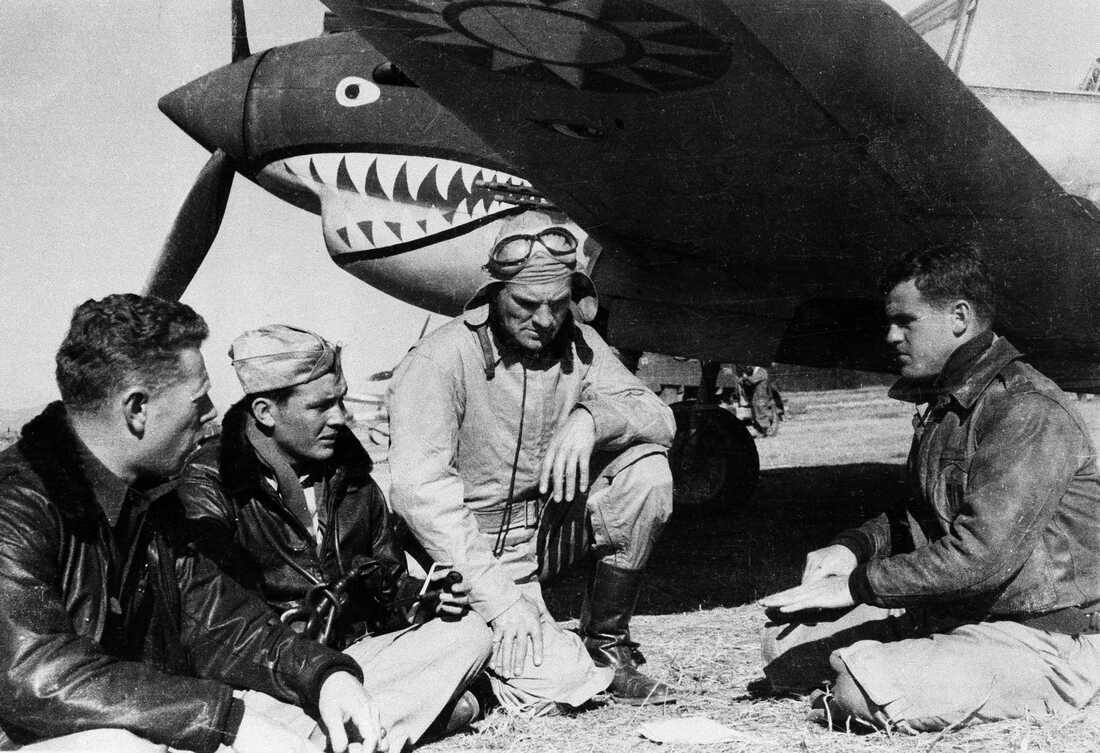
Pilots from the American Volunteer Grouping sit in front of a P-40 aeroplane in Kunming, China, on March 27, 1942. The group was notable for its unusual mission: Its members were mercenaries hired by China to fight against Nihon. AP hibernate explanation
toggle caption
AP

Pilots from the American Volunteer Group sit in front of a P-40 airplane in Kunming, China, on March 27, 1942. The group was notable for its unusual mission: Its members were mercenaries hired by China to fight against Nippon.
AP
Eighty years agone this week, a small group of American aviators fought in their first battle in World War Two.
Their mission was unusual: They were mercenaries hired past Red china to fight against Japan.
They were called the American Volunteer Grouping and later became known as the Flying Tigers. Though only in gainsay for less than seven months, the group became famous at the time for its power to inflict outsize damage on Japan'southward better-equipped and larger shipping fleet.
Their victories came when Japan seemed unstoppable. "The AVG was a brilliant spot in history when everything was bleak and black, and they accept received a lot of recognition for that," says Larry Jobe, president of the Flying Tiger Historical Organisation.
On the 80th anniversary of their first combat, here's an abbreviated history of how Americans ended upwardly fighting for China.
The Sino-Japanese war

Japanese troops rush in to assail Chinese soldiers at Changsha in 1939. In 1941, Japan was on the offensive in its war confronting China. Keystone/Getty Images hide explanation
toggle caption
Keystone/Getty Images
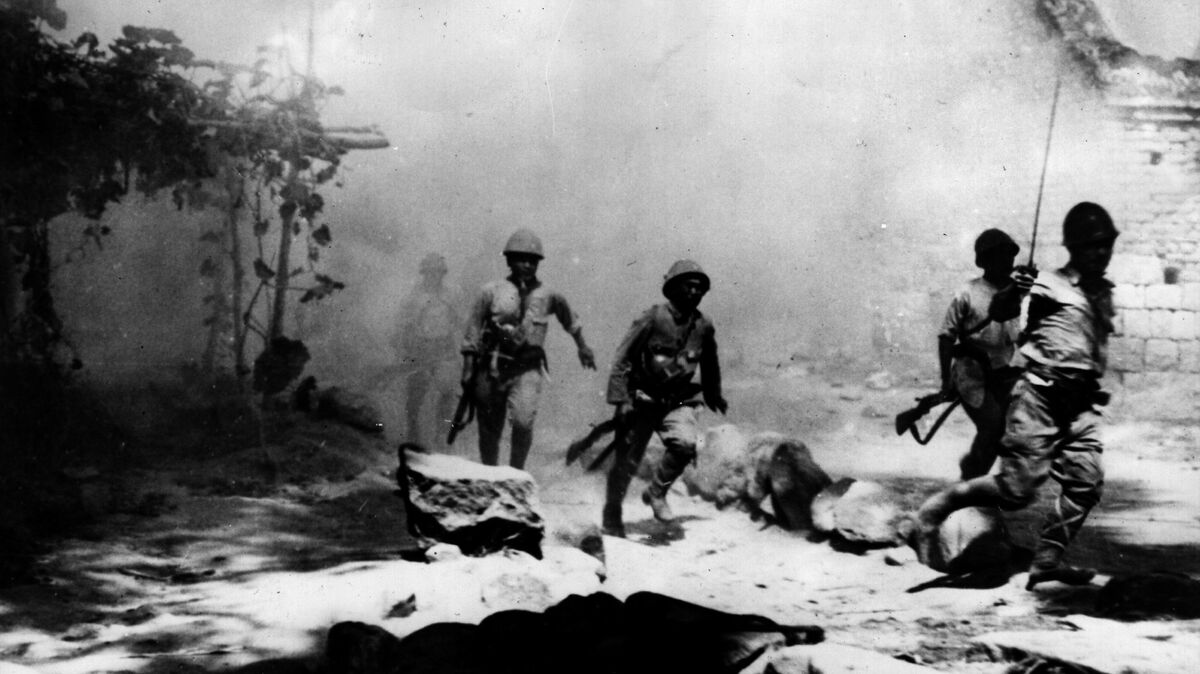
Japanese troops blitz in to attack Chinese soldiers at Changsha in 1939. In 1941, Japan was on the offensive in its war against Mainland china.
Keystone/Getty Images
In the West, 1939 is considered the offset of World War Ii. But in Asia, China and Nippon had been at war since 1937.
China was already fighting its own civil war betwixt the Nationalists of Chiang Kai-shek and Communist forces. The two sides came to a truce to fight against the Japanese. Prc, however, had petty air power to fend off Japanese bombings.
Enter Claire Lee Chennault, a U.Due south. Regular army aviator, instructor and tactician, once described past Time magazine every bit "lean, hard-bitten, taciturn." Health problems and disputes with his superiors pushed him into retirement from his position with the Ground forces Air Corps in 1937, at age 43.
But he quickly got a lucrative job offer with the Chinese Air Force, which was operating under Chiang'due south Nationalist government. Chennault was asked to come survey the readiness of its fleet.
"Chiang Kai-shek thought he had 500 airplanes," says Nell Chennault Calloway, who is Chennault'due south granddaughter and CEO of the Chennault Aviation & Military Museum in Monroe, La. "Chennault said, 'You have 500, but you only have 91 that fly.' That's how far behind they were in aviation."
Once the war with Japan officially broke out that summer, China hired Chennault as an adviser to its air force. He became its de facto commander.

Claire Lee Chennault first went to China to survey the Chinese Air Force'south readiness, and stayed on to lead the creation of the American Volunteer Group. Play a trick on Photos/Getty Images hide explanation
toggle caption
Fox Photos/Getty Images
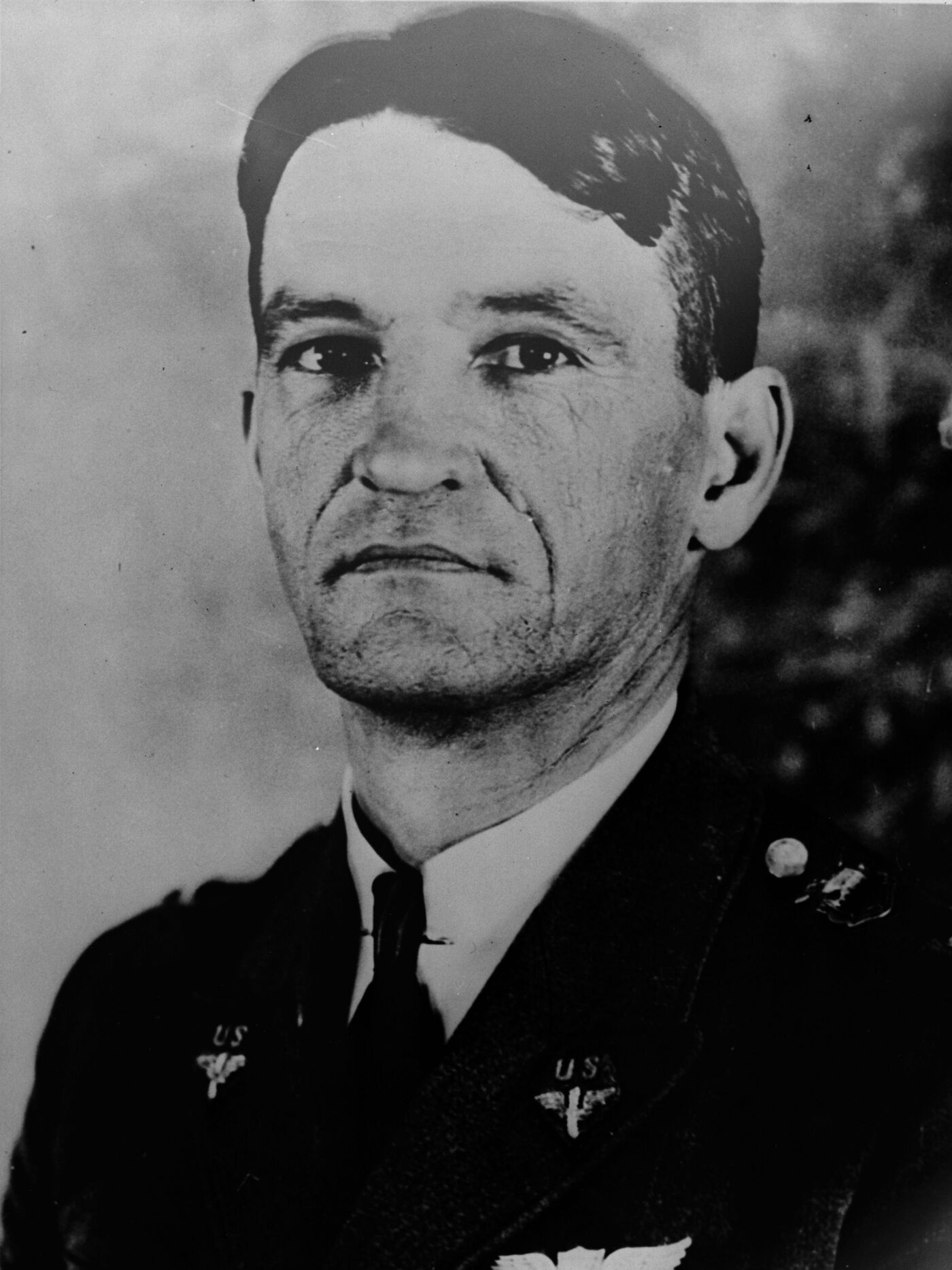
Claire Lee Chennault first went to China to survey the Chinese Air Force's readiness, and stayed on to pb the creation of the American Volunteer Grouping.
Fox Photos/Getty Images
By 1940, later losing backing from the Soviets, Mainland china badly needed more planes. At the fourth dimension, the U.South. was not officially part of Earth War II. But President Franklin Delano Roosevelt was concerned about the prospect of Nippon defeating China and turning its sights on the U.S.
Chennault traveled back to the U.South., pulling what strings he could to get planes. With the aid of T.Five. Soong, a Chinese official who was also Chiang'south blood brother-in-law, a deal was worked out to allow Prc to buy 100 American-made Curtiss P-forty fighter planes.
Equally for who would fly and maintain them, many of the pilots in China'south existing air force were poorly trained. So Chennault sent recruiters to U.S. armed forces bases.
"He managed to get Roosevelt to allow some of our military pilots — that was the original AVG — to resign their commissions in the U.Southward. military and go to China every bit mercenaries, basically, because it was against the international rules for any American military person to exist involved in the conflict over there," Jobe tells NPR.
This was mid-1941 — before Pearl Harbor and before the U.S. declared state of war on Japan.
"By using Chinese funds to purchase the aircraft and supplies and pay the salaries of the proposed crews, the U.S. government could retain a façade of neutrality, while helping China against the Japanese," the Department of Defense's history of the Flying Tigers explained.
To brand recruitment easier, pilots and mechanics were offered pay that was often more than double what they were making before.
So in summer and fall of 1941, 99 pilots — 59 from the Navy, 7 Marines, and 33 from the Army — traveled to Asia, along with most 200 support coiffure, co-ordinate to the DOD'due south history. Virtually a dozen of them were Chinese Americans, says Yue-him Tam, a Macalester College history professor who studies People's republic of china and Nihon.
Those who traveled had various motivations — a alter of scenery or a run a risk to testify their skills in combat. Calloway thinks many stayed to help with the "desperate situation" in China. Some came for the money.
Airplane pilot Gregory "Pappy" Boyington, who would proceed to receive the Medal of Accolade and the Navy Cross, told Aviation History Magazine in the 1980s: "I resigned my committee and accustomed the job with the AVG in September 1941, since rank was tiresome in coming and I needed the money. ... And with an ex-wife, three kids, debts and my lifestyle, I really needed the work."
Burma was central to keeping China supplied
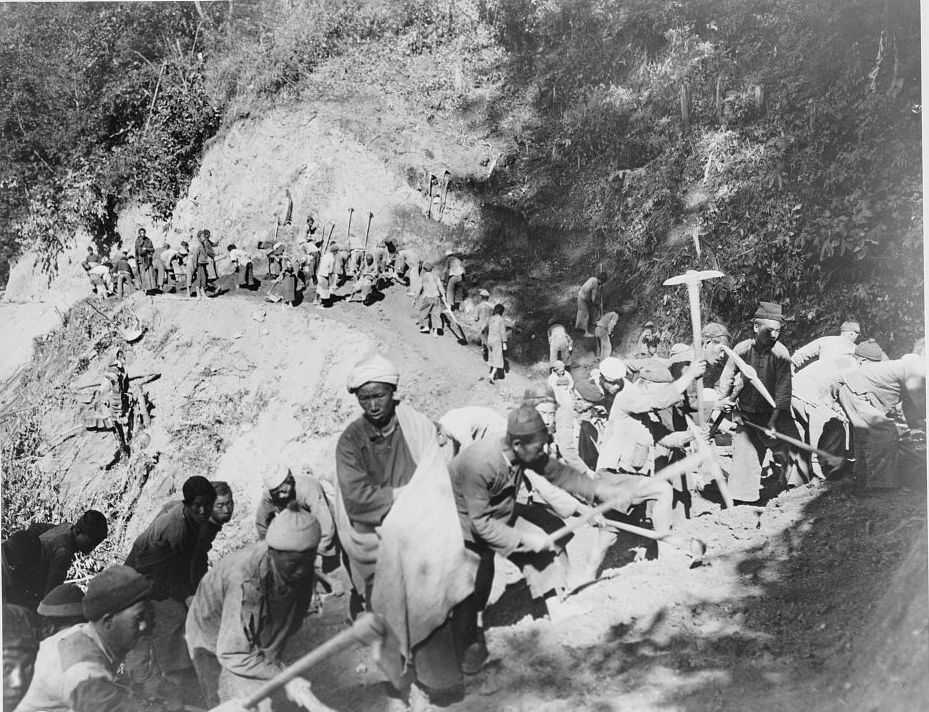
Chinese laborers working to repair the Burma Road in southwest Mainland china, circa 1944. During World War Two, this long windy road from Burma through the mountains was essential to keeping Red china supplied. U.S. Army Signal Corps/Library of Congress hibernate caption
toggle caption
U.S. Regular army Signal Corps/Library of Congress

Chinese laborers working to repair the Burma Road in southwest Red china, circa 1944. During World War II, this long windy road from Burma through the mountains was essential to keeping China supplied.
U.S. Army Signal Corps/Library of Congress
The AVG'south base was in Kunming in southwestern China, far from areas nether Japanese occupation.
There was a hitch to being there, however — no runways to country planes.
Then thousands of Chinese built them past hand. "The Chinese people — the peasants, the working class people in particular, too — volunteered to help to build those runways and airports and also provide services to the American pilots," Tam tells NPR. "They didn't have any tools, modern tools. They used their blank hands, actually, to build those runways."
Meanwhile, the Americans did some preparation at a British airfield in Burma, the land now called Myanmar.
Their early training was non particularly successful. The pilots had far less experience than Chennault had wanted. Three pilots died and planes and equipment were damaged in various accidents.

Members of the American Volunteer Group flew Curtiss P-40 planes, pictured. Past performing certain maneuvers, they were able to exploit some weaknesses in the Japanese shipping. 3 Lions/Getty Images hide explanation
toggle caption
3 Lions/Getty Images

Members of the American Volunteer Group flew Curtiss P-twoscore planes, pictured. By performing sure maneuvers, they were able to exploit some weaknesses in the Japanese aircraft.
Three Lions/Getty Images
It wasn't long before they had to put their training to use. The Flying Tigers' first combat came on December. 20, 1941 — 13 days later on Pearl Harbor and 12 days after the U.South. declared war on Nippon. Japanese bombers attacked the AVG base at Kunming.
The AVG "shot downwardly nine of 10 Japanese bombers. So they were the first Americans actually to accept a victory in World War Ii," Calloway says. Their but loss was i AVG plane that the pilot crash-landed after running out of gas; he was uninjured, co-ordinate to the DOD'southward history.
In the following days, the focus of their combat quickly shifted to nearly Rangoon, Burma. Burma was a British colony at the time and the AVG would assist the British air strength in defending Rangoon confronting Japanese attacks.
Burma was of vital importance to People's republic of china'southward war efforts. Japan had sealed off China's coast from supply lines, so Communist china depended on supplies coming in from the port of Rangoon over the mountainous Burma Route to Kunming.
The planes of the AVG, the Curtiss P-forty, were not as good as those of the Japanese. But by performing certain maneuvers as outlined by Chennault — namely, high-speed diving and climbing — the AVG pilots were able to exploit some weaknesses in the Japanese shipping.
"Although, the A.V.G. was blooded over Communist china, it was the air battles over Rangoon that stamped the authentication on its fame as the Flight Tigers," Chennault subsequently wrote in his memoir Mode of a Fighter, equally quoted by the AVG Flight Tigers' official website.

Pak On Lee of Portland, Ore., George Lum of New York City, and Kee Jeung Pon of New York Urban center were amidst the Chinese American mechanics who served in the AVG. Here they are pictured in Kunming, Red china, in Nov 1942 working on a Curtiss P-40 of the 23d Fighter Group, which evolved from the AVG. Department of Defence force, Department of the Air Force/National Archives hide caption
toggle explanation
Section of Defense, Department of the Air Force/National Athenaeum

Pak On Lee of Portland, Ore., George Lum of New York Urban center, and Kee Jeung Pon of New York City were among the Chinese American mechanics who served in the AVG. Here they are pictured in Kunming, People's republic of china, in Nov 1942 working on a Curtiss P-40 of the 23d Fighter Group, which evolved from the AVG.
Section of Defense, Department of the Air Force/National Athenaeum
Fighting continued through January and Feb 1942 in Burma and Japanese-controlled Thailand.
"They are credited with shooting down 299 Japanese airplanes confirmed, nigh that many unconfirmed, and only lost 12 of their ain in actual combat, which is a record that'due south never been cleaved to this twenty-four hour period," Calloway says.
The Japanese forces, however, outnumbered and overpowered the AVG and the British. Rangoon fell in March 1942. But their efforts slowed downwardly the Japanese accelerate, kept supply lines open and helped Mainland china go on to fight.
The AVG was integrated into the U.Due south. military

Pilots of the Flying Tigers run for their Curtiss P-forty fighters equally an air raid warning sounds at an unknown airbase in China on Nov. 2, 1943. The AVG was integrated into the U.Southward. military in 1942 as office of the 23d Fighter Group, which connected to use the name Flying Tigers. AP hibernate caption
toggle caption
AP
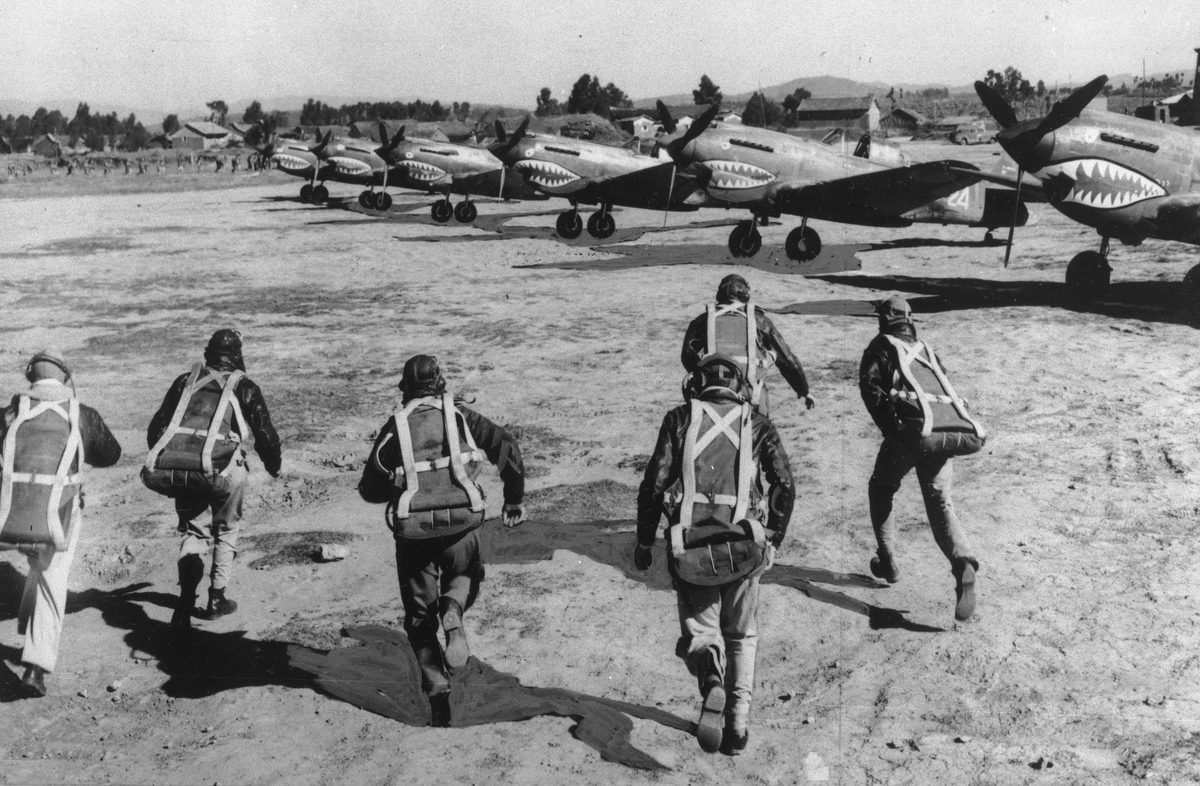
Pilots of the Flight Tigers run for their Curtiss P-twoscore fighters as an air raid warning sounds at an unknown airbase in Mainland china on Nov. 2, 1943. The AVG was integrated into the U.S. war machine in 1942 as part of the 23d Fighter Group, which continued to use the name Flying Tigers.
AP
By this point, the U.Southward. was formally at war with Japan and there was no demand for pretense. U.S. military leaders pushed for the AVG to be absorbed into the U.S. Ground forces Air Forces. Chennault rejoined the Regular army in April 1942.
The AVG connected to fly missions into the jump and summertime, including stopping a Japanese accelerate over a crucial river gorge in May, later on which Japan "never once more threatened" Prc from the west, the DOD history notes.
On July 4, 1942, the AVG was officially integrated into the new 23d Fighter Group. A handful of pilots and support coiffure stayed on, but most of the men from the original AVG rejoined their previous branch of the military. Others became civilian ship pilots in Prc or went back to the U.South. to work as civilians.
Chennault was promoted to brigadier general and led the Mainland china Air Task Force, which included the 23d and other units, before assuming command of the 14th Air Force in China in March 1943. He stayed in Prc for the rest of the state of war, before retiring from the armed services (over again) in 1945.
An lxxx-year legacy

A visitor walks past the images and old uniforms of the Flying Tigers at the Anti-Japanese War Museum in Dayi county in Cathay's Sichuan province in 2005. Museums and memorials in People's republic of china and the U.S. remember the AVG. Liu Jin/AFP via Getty Images hide caption
toggle caption
Liu Jin/AFP via Getty Images

A company walks by the images and erstwhile uniforms of the Flying Tigers at the Anti-Japanese War Museum in Dayi county in China'south Sichuan province in 2005. Museums and memorials in China and the U.S. remember the AVG.
Liu Jin/AFP via Getty Images
The AVG quickly gained fame in the U.S. and Communist china for its early victories — information technology was a morale boost when the war was going in Japan'due south favor.
Information technology'southward unclear who came up with the nickname "Flying Tigers," though it was used equally early on as a calendar week after their starting time boxing, when Fourth dimension mag said the "Flight Tigers swooped, let the Japanese take it." Other publicity came when T.V. Soong, who had earlier worked with Chennault in Washington to gather the planes, helped get The Walt Disney Company pattern the group'south logo of a Bengal Tiger jumping through a Five for victory sign. And John Wayne played a character based on Chennault in the 1942 movie Flight Tigers.
Today there are several plaques, memorials and museum exhibits dedicated to the Flying Tigers in Prc, the U.South., Taiwan and Thailand. The Flying Tiger Heritage Park opened in 2015 in the southern Chinese city of Guilin, built in collaboration with Jobe's Flying Tiger Historical Organization.
The final surviving member of the original AVG, Frank Losonsky, died in Feb 2020.

A grouping of 52 U.S. World State of war II veterans who had served in China, including members of the Flying Tigers, visit Chongqing, China, in 2005 to nourish memorial events. China Photos/Getty Images hide caption
toggle caption
Red china Photos/Getty Images
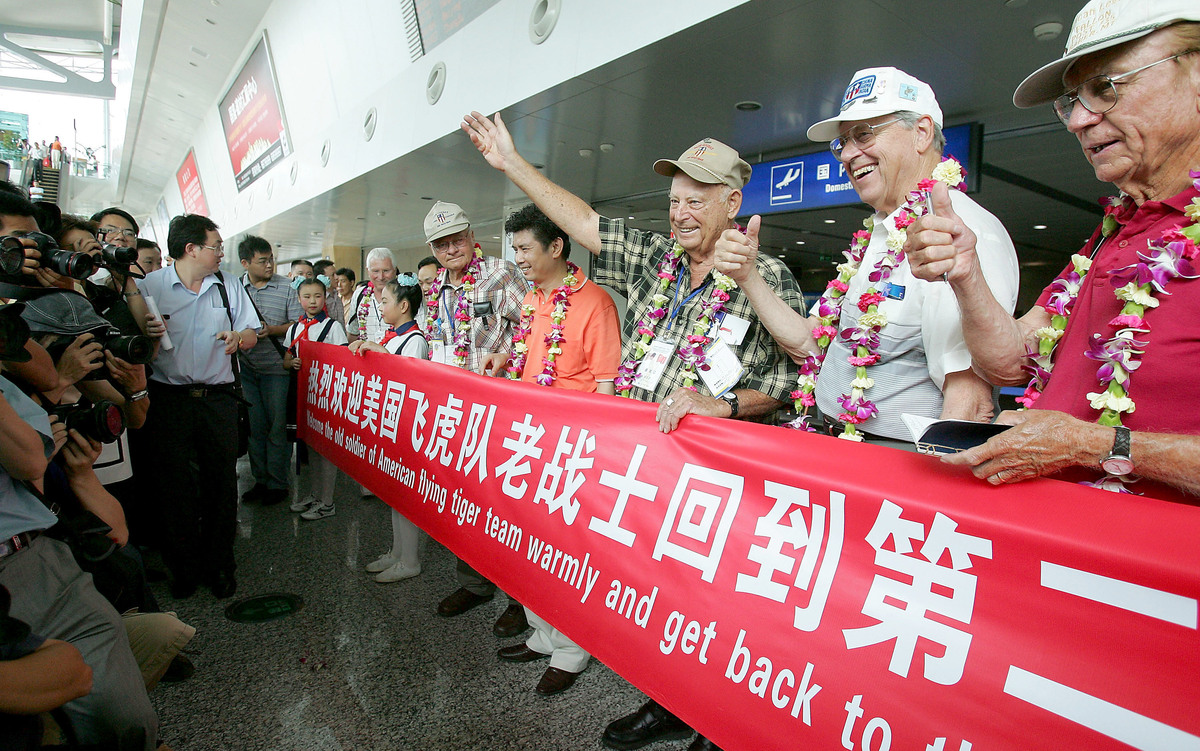
A group of 52 U.S. World State of war 2 veterans who had served in China, including members of the Flying Tigers, visit Chongqing, Communist china, in 2005 to attend memorial events.
China Photos/Getty Images
Flying Tigers historians are quick to point out how essential ordinary Chinese people were to the mission. Those who paved runways did so every bit volunteers, Tam says, "to aid the American fighters because they were fighting for China, fighting for freedom."
Chinese villagers also suffered immensely to help when pilots were shot down. "The Japanese would go into these villages and they would torture and mutilate and kill the villagers in an attempt to find out where the Flying Tigers were. And in well-nigh instances, the villagers would not tell them," Jobe says. "They would endure the consequences."
"I recall, really, the remembrance and the respect for the Flying Tigers was really genuine in China," Tam says.
"The people of the Us volunteered to assist Cathay. They put their lives at risk to save the Chinese," he adds, leading many Chinese to retrieve of those Americans as "e'er friends of China."
crouchthosinglone.blogspot.com
Source: https://www.npr.org/2021/12/19/1062091832/flying-tigers-americans-china-world-war-ii-history-japan
0 Response to "Did Chinese Fitght Agains Japan After Pearl Harbor"
Enregistrer un commentaire